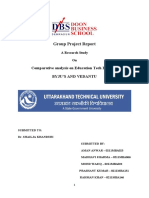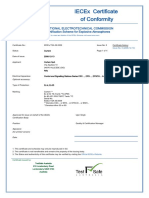At a glance
Powered by AI
The key takeaways are that India has one of the largest education systems in the world with over 260 million students enrolled in schools. However, there is still potential for further development and growth in the education sector.
RAMAIAH INSTITUTE OF MANAGEMENT, BANGALORE - 1 -
CHAPTER 1 INDUSTRY PROFILE
RAMAIAH INSTITUTE OF MANAGEMENT, BANGALORE - 2 -
1. Introduction to Education Consulting Industry:
1.1 History
Educational Consultants India Limited was incorporated as a public-sector enterprise by the Government of India in 1981. From 2009, the company has adopted new logo and is known as Ed. CIL (India) Limited. The Government of India has designated Education Consultants of India (Ed. CIL) as the Single Window agency to facilitate the admission of children of Indian Diaspora and foreign students.
1.2 Introduction
India holds an important place in the global education industry. The country has more than 1.5 million schools with over 260 million students enrolled and about 751 universities and 35,539 colleges. India has one of the largest higher education systems in the world. Around 35.7 million students were enrolled in higher education in India during 2016-17. However, there is still a lot of potential for further development in the education system. India has become the second largest market for e-learning after the US. The sector is currently pegged at US$ 2 billion and is expected to reach US$ 5.7 billion by 2020. The distance education market in India is expected to grow at a Compound Annual Growth Rate (CAGR) of around 11 per cent during 2016-2020. Moreover, the aim of the government to raise its current gross enrolment ratio to 30 per cent by 2020 will also boost the growth of the distance education in India.
1.3 Market Size
The education sector in India is poised to witness major growth in the years to come as India will have
world’s largest tertiary
-age population and second largest graduate talent pipeline globally by the end of 2020. The education market in India is currently valued at US$ 100 billion and is expected to nearly double to US$ 180 billion by 2020. Currently, the school segment is valued at
RAMAIAH INSTITUTE OF MANAGEMENT, BANGALORE - 3 -
US$ 52 billion and contributes 52 per cent to the education market in India, higher education contributes 15 per cent of the market size, text-book, e-learning and allied services contribute 28 per cent and vocational education in manufacturing and services contributes 5 per cent. Higher education system in India has
undergone rapid expansion. Currently, India’s higher
education system is the largest in the world enrolling over 70 million students while in less than two decades, India has managed to create additional capacity for over 40 million students. It witnesses spending of over Rs 46,200 crore (US$ 6.93 billion).
1.4 Investment/Recent Developments
The total amount of Foreign Direct Investments (FDI) inflow into the education sector in India stood at US$ 1.67 billion from April 2000 to December 2017, according to data released by Department of Industrial Policy and Promotion (DIPP). The education and training sector in India has witnessed some major investments and developments in the recent past.
Some of them are:
The Indian Institute of Technology, Delhi has been ranked 145 in the Global University Employability Ranking 2017, based on hiring by top companies.
India has signed a loan agreement with World Bank under 'Skills Acquisition and Knowledge Awareness for Livelihood Promotion' (SANKALP) Project to enhance institutional mechanisms for skills development.
Singapore is going to open its first skill development centre in Assam, which will provide vocational training to youth in the region.
Dabur India Ltd has opened a skill development centre for women in Dhekidol village in the state of Assam that will provide rural women with improved employment and self-employment opportunities
1.5 Government Initiatives
Some of the other major initiatives taken by the Government of India are:
RAMAIAH INSTITUTE OF MANAGEMENT, BANGALORE - 4 -
The allocation for school education under the Union Budget 2018-19 is expected to increase by 14 per cent, to focus on accelerating existing schemes and quality improvement.
The state of Uttar Pradesh is set to have about 5,000 state government-run English medium primary schools which are expected to start functioning from the next academic year, stated Ms Anupama Jaiswal, Minister of State for Basic Education, Government of Uttar Pradesh.
In order to boost the Skill India Mission, two new schemes, Skills Acquisition and Knowledge Awareness for Livelihood Promotion (SANKALP) and Skill Strengthening for Industrial Value Enhancement (STRIVE), have been approved by the Cabinet Committee on Economic Affairs (CCEA), Government of India, with an outlay of Rs 6,655 crore (US$ 1.02 billion) and will be supported by the World Bank.
India's first Pradhan Mantri Kaushal Kendra (PMKK) for Skilling in Smart Cities has been inaugurated by the Ministry of Skill Development and Entrepreneurship, Government of India in partnership with New Delhi Municipal Council (NDMC) with the purpose of increasing the pace of skilling through collaboration.
The Government of India is working towards improving the doctor population ratio and has added over 5,800 PG seats in government medical colleges this year, according to Mr Ashwini Kumar Choubey, Minister of State (Health and Family Welfare), Government of India.
The Government of India has signed a Financing Agreement with the World Bank for IDA credit
of US$ 125 million for the “Skills Strengthening for Industrial Value Enhancement Operation (STRIVE) Project”.
NITI Aayog is launching the Mentor India Campaign which will bring leaders and students together at more than 900 Atal Tinkering Labs in India, as part of the Atal Innovation Mission. Moreover, it has selected 1,500 additional schools across India for establishing Atal Tinkering Labs (ATLs) under the Government of India's flagship programme, Atal Innovation Mission (AIM).
The Government of India will spend around Rs 20,000 crore (US$ 3.10 billion) to build six new Indian Institutes of Technology (IITs) by March 2024, of which Rs 7,000 crore (US$ 1.08 billion) will be spent by March 2020.


























































































